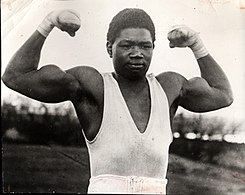Battling Siki
| Battling Siki |
|
|---|---|
|
Battling Siki |
|
| Data | |
| Birth Name | Amadou M'Barick case |
| Weight class | Light heavyweight |
| nationality |
|
| birthday | September 16, 1897 |
| place of birth | St. Louis , French West Africa |
| Date of death | December 15, 1925 |
| Place of death | new York |
| size | 1.79 m |
| Combat Statistics | |
| Struggles | 90 |
| Victories | 63 |
| Knockout victories | 35 |
| Defeats | 22nd |
| draw | 5 |
Amadou M'Barick case or Baye case , later also Louis M'Barick case (born September 16, 1897 in Saint-Louis , Senegal ( French West Africa ), † December 15, 1925 in New York City ) was under the name Battling Siki known as a French boxer . He was the first world boxing champion to be born in Africa.
Professional career

At the age of eight, Baye Fall came to Paris from what is now Senegal , according to his own reports as a servant of a Dutch dancer. He later earned his money a. a. as a dishwasher.
He started boxing at the age of 15; from 1912 to 1914 he completed 16 fights, of which he won eight. The First World War , in which he served as a soldier, was injured and also decorated, interrupted his sporting career.
In 1919, Fall resumed boxing under the pseudonym “Battling Siki”. His most spectacular fight is the one against the popular French light heavyweight world champion Georges Carpentier on September 24, 1922 in the Buffalo Stadium near Paris. In front of around 40,000 spectators, Battling Siki won the fight by knocking out in the sixth round. The triumphant Carpentier reportedly said before the fight: "Dépêchons-nous donc, il va pleuvoir." ( French for "Make Let's fast, it's going to rain soon.") Siki later stated that he had originally been directed to submit this Losing battle. However, the atmosphere in the stadium and his conviction of his own strength triggered a change of heart so that he wanted to win the fight.
Siki's fight in March 1923 against the Irish boxer Mike McTigue in Dublin in the Scala Theater was also memorable : Since the Irish Civil War was raging at the same time, shots and explosions could be heard during the athletic fight in the theater. Battling Siki just lost on points. After losing a fight and the title of European Champion to Emile Morelle by disqualification in June 1923 , he moved to the United States , but was increasingly unsuccessful as a boxer.
Outside the boxing ring
Although Battling Siki was very popular in Paris, he was not immune to racism. Some journalists called him “Championzee” (as an allusion to the French word chimpanzé , “chimpanzee”) and “jungle child” or assumed that some victories were awarded to him precisely because of his skin color. Siki publicly defended himself against this hostility, but also played with his image by taking a walk with a leashed lion. He led an extravagant life, tended to expensive clothes, but also to fights and excessive alcohol consumption, and married two white women one after the other, which earned him additional resentment.
Even after moving to New York, Battling Siki was notorious for his behavior: he also shot a revolver in the air, drank a lot, and then refused to foot the bill in bars.
Death and exhumation
On December 15, 1925, Battling Siki left his New York apartment to meet up with friends. On the same day he was found dead nearby in the so-called Hell's Kitchen district; he had been killed with two shots at close range. It was speculated that he defied instructions from the Mafia or got into a gang war.
In December 1993, his remains, which were buried in Flushing Cemetery in Queens , were transferred from the United States to his birthplace in Senegal and buried there according to the Muslim rite. Although he was Muslim, his widow had him buried in a Christian manner in 1925.
The Mémorial Battling Siki for young boxers with several hundred participants has been held in Saint-Louis in his honor since 2008 .
literature
- Peter Benson: Battling Siki: A Tale of Ring Fixes, Race, and Murder in the 1920s , University of Arkansas Press 2006, ISBN 155728816X .
- Jean-Marie Bretagne: Battling Siki , Éditeur Philippe Rey, coll. À Tombeau Ouvert 2008, ISBN 2848761091 .
- Herman Grégoire: Le Boniment de Battling Siki , illustré par Raymond Gid, éditions Guy Lévis Mano 1934.
Movie
- Nick Koppen: Siki . Documentary. 1992.
Web links
- Battling Siki in the BoxRec database
- Paul Yange: Battling Siki: premier africain champion du Monde de boxe on saintlouisdusenegal.com (French)
- Video of the fight between Battling Siki and Georges Carpentier on dailymotion.com
Individual evidence
- ↑ a b David Signer: The short, wild life of Battling Siki. NZZ, June 22, 2018, accessed on September 25, 2018 .
- ↑ The New York Times v. March 28, 1993: Battling Siki Finally on His Way Back Home on nytimes.com (English)
- ↑ ministère des Sports, December 2008: Saint-Louis en fête! ( Memento from December 20, 2011 in the Internet Archive )
- ↑ Battling Siki in the Internet Movie Database (English)
| personal data | |
|---|---|
| SURNAME | Siki, battling |
| ALTERNATIVE NAMES | Fall, Amadou M'Barick (real name); Fall, baye; Case, Louis M'Barick |
| BRIEF DESCRIPTION | French boxer and the first world boxing champion |
| DATE OF BIRTH | September 16, 1897 |
| PLACE OF BIRTH | Saint-Louis , French West Africa |
| DATE OF DEATH | December 15, 1925 |
| Place of death | New York City |

